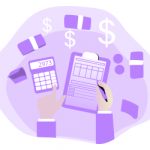An experience map is an all-encompassing visualization of a customer experience with a product or a service over time. A valuable tool in the UX professionals’ toolbelt, experience mapping continues to evolve, but where is it going?
And who can better answer this question than a seasoned UX designer and an author of 3 books, including a bestseller, Mapping Experiences: A Complete Guide to Creating Value through Journeys, Blueprints, and Diagrams. Jim Kalbach recently shared his insights into the changes and new trends in the realm of experience mapping at our online event.
Contents
Experience mapping background
“You’ve got to start with the customer experience and work backwards to the technology — not the other way around.”
This statement by Steve Jobs embodied the movement that started around the 1990-s and aimed to reverse the equation of software design and services. That’s the time when the user experience and user-centered design came together and became relevant to business. As UX became an imperative, we needed a way to talk about it because experience is very hard to define. And one of the ways to talk about this imperative was to map it out. That’s when mapping became popular, taking the form of customer journey maps, service blueprints, and diagrams.
Here’s an example of a simple diagram for going to the ophthalmologists. The diagram, basically, has two parts — the experience and the service. The top part is a snapshot of an experience together with emotions, thoughts, and feelings over a long time. The bottom part is what the product, or service in this case, has to do to make that experience happen.
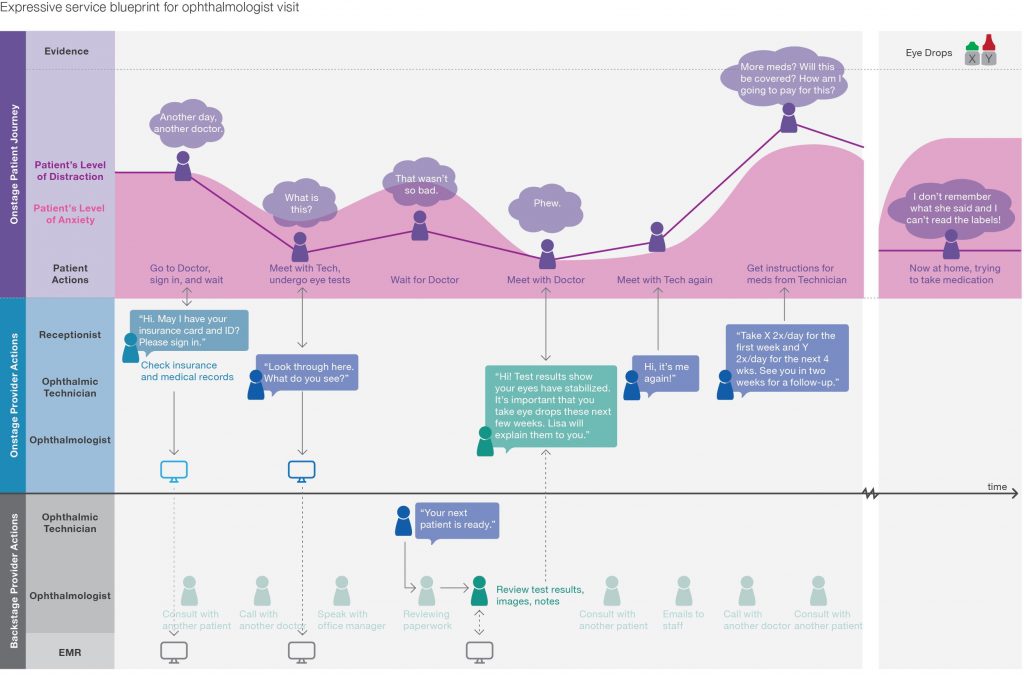
As the diagram is visual and very compact, it makes that fuzzy concept of experience more tangible and much easier to discuss. If this map were a 20-pages report, it would have been harder for the team to fully understand the connections and see the bigger picture.
The visual aspect is really important, too. Here’s a diagram from Jeff Patton's book called User Story Mapping.
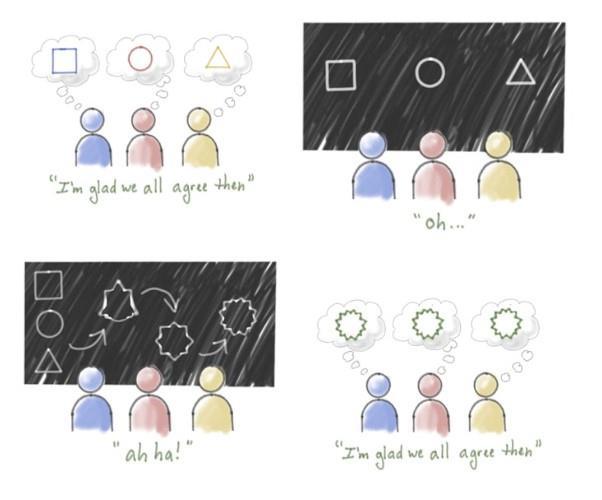
It is not uncommon when we have a group of people thinking they all agree with each other up until they put it on the blackboard. That’s when they can see the difference and start negotiating.
There are many different ways to map the experience — customer journey mapping, service blueprinting, experience mapping, a workflow diagram, a mental model diagram. But fundamentally they all do the same thing. They allow us to get a nice, tangible, concrete view of the experience so that we can then work out the right technology.
With that in mind, let’s move to the five trends that are worth paying attention to.
Facilitation
Facilitation is not necessarily a new trend, but it’s getting more emphasis since the ultimate function of an experience map is facilitating conversations.
An experience map is not an external deliverable but rather an internal diagnostic tool that empowers your team with a better understanding of the customer journey. However, there are no inherent answers that pop off of the map. To get them, you need to facilitate a conversation first.
Below is a general representation of what a mapping session can look like. You can see people with pencils and sticky notes, standing up and having a conversation, with a map in the background.
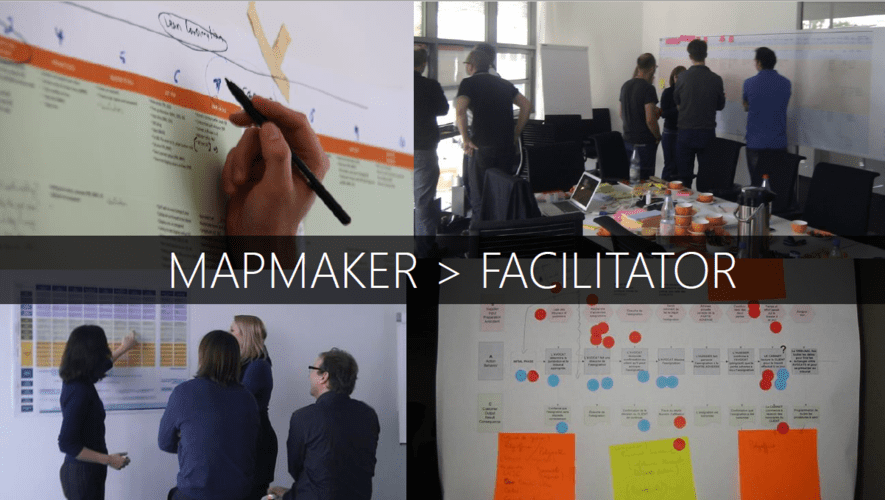
These conversations are the foundation for a further sense-making process that actually helps the team to gain insights and see the opportunities. But how can you actually facilitate a conversation?
One of the exercises that you can try during a mapping workshop is to prepare a chronology with different phases that your customer is going through. Then have your team divided into groups and ask the groups to grade themselves for how well they support the customer at each one of those phases.
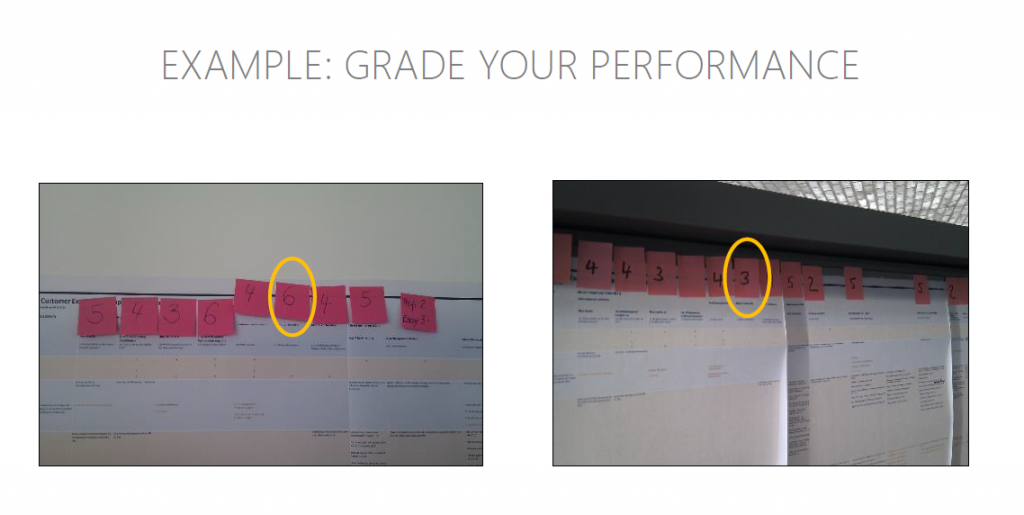
In the example above, the groups graded their performance from one to six, with six being the worst grade and one — the best. Surprisingly, different groups assessed the same phase differently. When team members got back together, an immediate conversation started, and it turned out that there was something that one group knew that the other group didn't, which resulted in an “aha” moment for the company and the team.
It’s these types of conversations that you have to think about and actually calibrate your mapping heading towards them. That’s why after you have become a mapmaker, you need to become a facilitator.
Multichannel
Mapping an experience of a single product with a single persona is fairly straightforward. But today we operate in much larger contexts like a B2B situation with dozens of stakeholders and different experiences.
Here's a touchpoint matrix from Wolfram Nagel’s book Multiscreen UX Design. What Wolfram tries to do is to coordinate all the channels and screens that a customer is using. You can take that last row and have a whole conversation just around how your product moves from screen to screen and how that motion affects the overall experience.
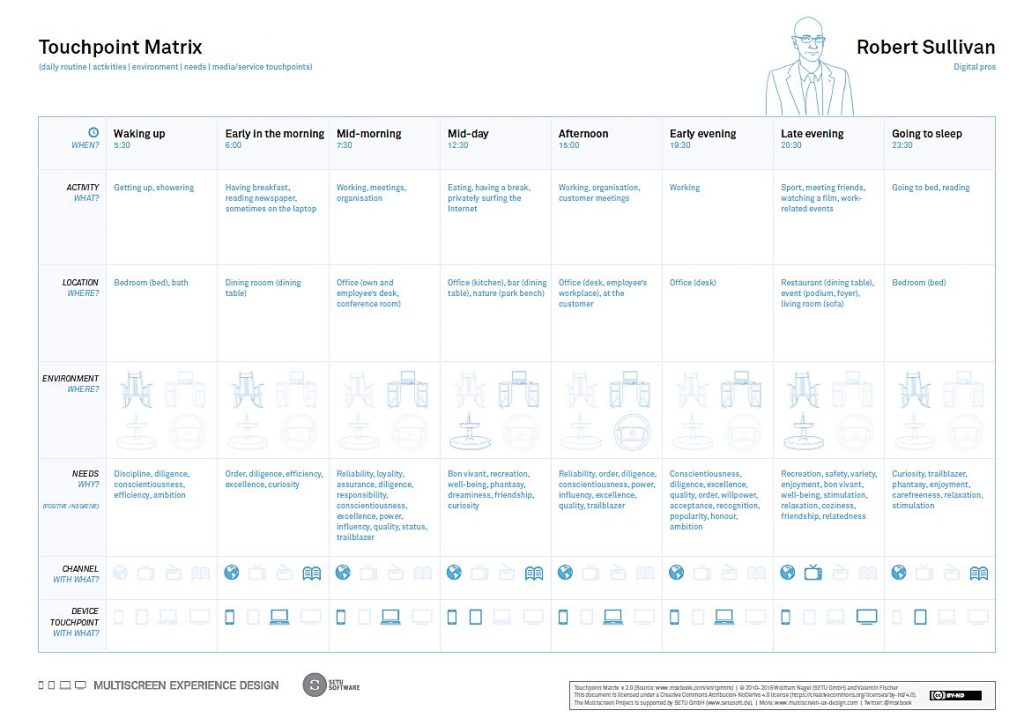
There are different techniques that can help you understand different devices, screens, and multiple personas. One of the ways is to double up on the rows if you have a map in the table-like format.
The example below shows how you can look at three different personas over the same stretch of time and easily compare their experiences.
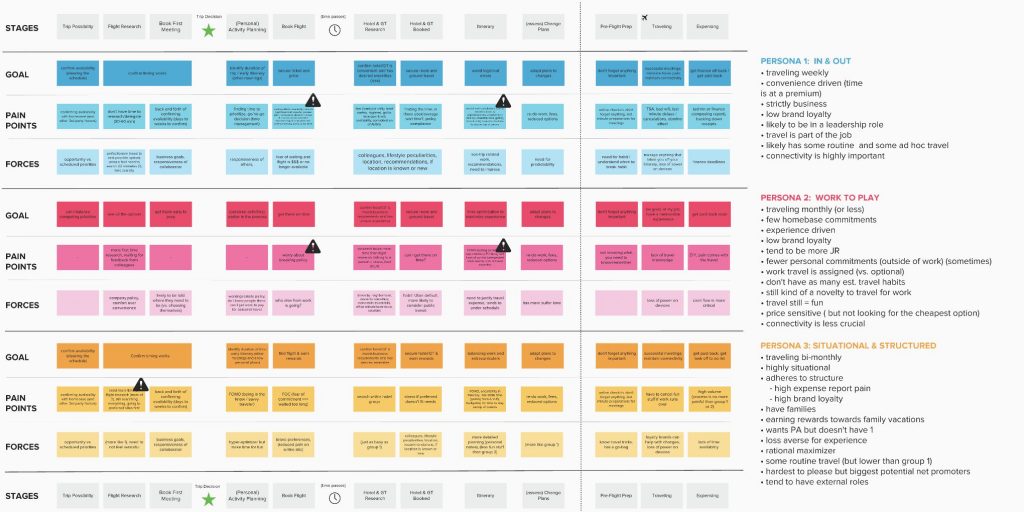
And that’s the power of mapping. Because it's visual, you can go up and down, align customer journeys, and pinpoint hotspots. As a result, you’ll get a fertile ground for a conversation.
Journey management
Mapping the as-is experience is great because it helps you discover pain points and find solutions for them. But in addition to that generative type of mapping, there is a whole other class of mapping that looks at journey management over time and helps measure the effectiveness of touchpoints and interactions.
There are even special solutions designed to help companies manage customer experiences over time.
Once you have created a customer journey map with all the metrics you want to track, you can use it in a data-driven way to see what’s happening over time and where your drop-off points are.
The process is a lot less creative as it is more management-driven. Instead of a group of people, you have one or two persons who are monitoring the map over time and highlighting things like a drop or improvement in metrics. There is even a new role, a journey manager, for people to manage journeys over time.
Employee experience
From HR professionals to people ops, employee experience has become the center of attention for a lot of people who are looking at employees as a workforce and thinking about their experience.
EX goes way beyond employee engagement or work-life balance. You are looking at employees as individuals and trying to understand how they develop, what the purpose of their employment is, how they approach their careers, and so on. In other words, you are looking at their overall experiences and trying to manage that.
Good news is that all the tools that you know from UX, personas, and mapping can apply to employee experience, too. By leveraging these tools, you can get a map like below. This is a journey map describing a day in the life of Rachel.
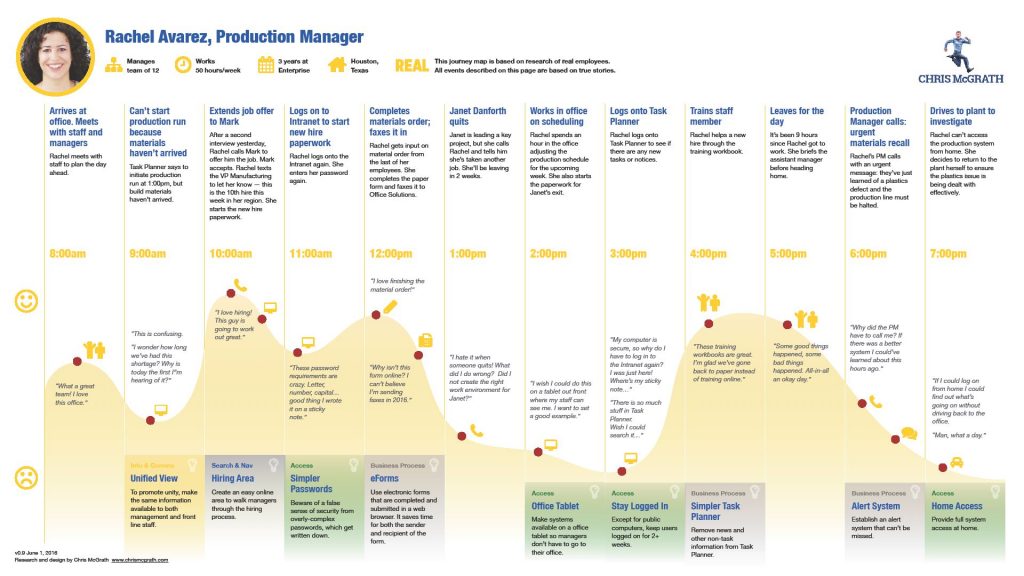
Since we are looking at employees as goal-driven individuals, you can see the emotions, thoughts, and feelings. However, this map doesn't give you any answers. You have to think as an organization — how can we make Rachel's experience working with us better?
The key thing here is that the user experience and the customer experience are directly related to the employee experience. There’s even research that shows that if you have a better EX, you will improve your CX as well.
It also works the other way around. To be customer-centric, you need to be employee-centric as it’s very unlikely that you will have a great customer experience and a miserable and unsatisfied workforce. But if your employees are aligned with your mission as a company, share your vision, and feel that they have a comfortable and safe work environment, that’s just the springboard into a great customer experience.
And you can actually map the two together. Just have a look at the use case below. That’s the onboarding flow at Mural. This map allows us to look at what the employees at Mural are going through and who is involved at those touchpoints. With this information at hand, we can think about how we can make those people happier and how we can make those touchpoints better.
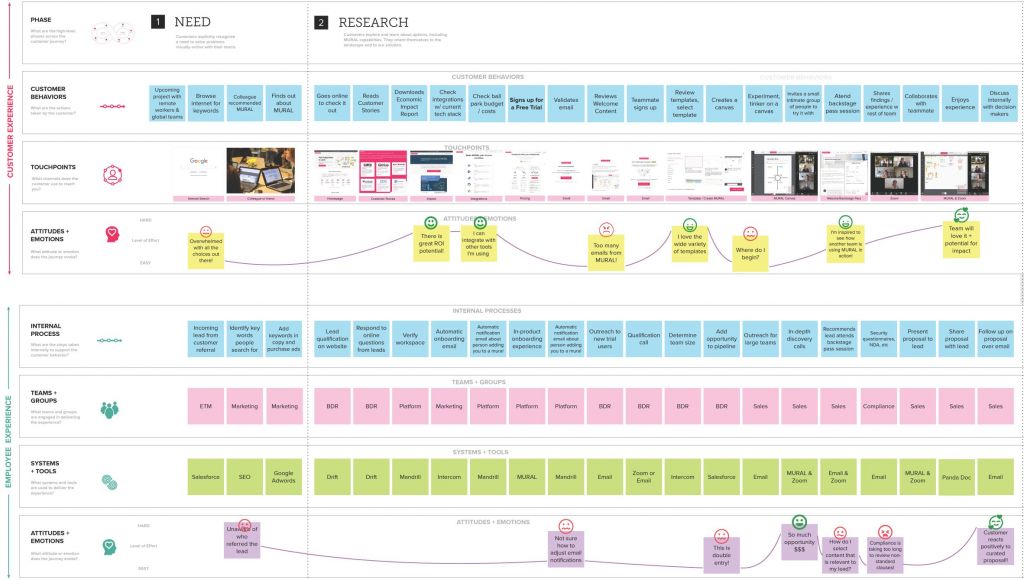
Design for the greater good
When we talk about experience, it’s more than just a product experience. Experience is all of the thoughts and feelings that human beings have when being involved in a goal-driven task over time.
Today, we start seeing a lot of applications of experience mapping far outside of commercial settings. Government, education, and even non-profits are trying to solve some of the bigger challenges that we have as a society.
One such project gathered together UX experts to use design to help people who are experiencing homelessness. For that, they used personas, empathy maps, and journey maps to describe a day in the life of a homeless person. This diagrammed map of homelessness can further be used to find opportunities to fight the problem.
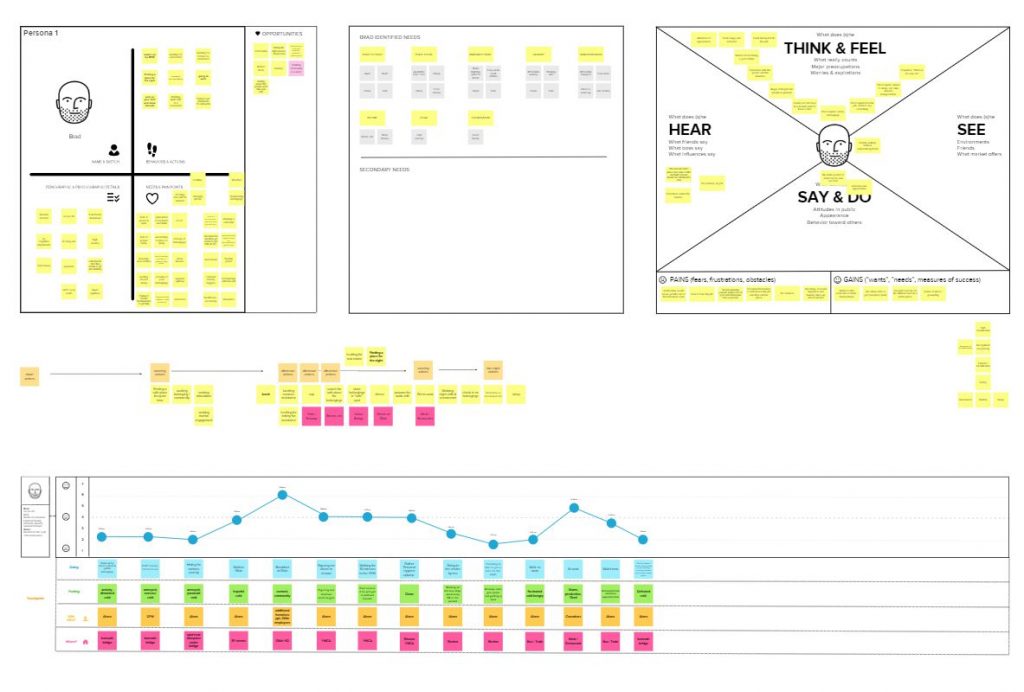
Key takeaways
There are five major directions that experience mapping can go:
- Facilitation. After you create a map, you need to put your facilitator hat on and start a conversation.
- Multichannel design. Think about multiple personas, as well as different screens and channels.
- Journey management. Stay on top of a user journey over time.
- Employee experience. Focus on delivering positive EX to see gains with CX.
- Design for the greater good. Experience mapping can be used far outside of commercial settings to solve complex challenges.
The video
Want to learn even more about experience mapping and see the Q&A session? See the recording below:

